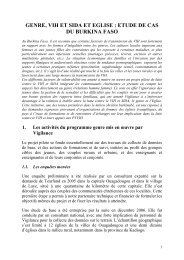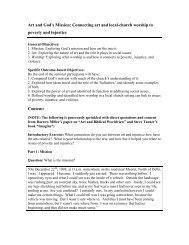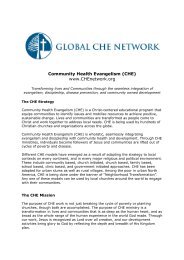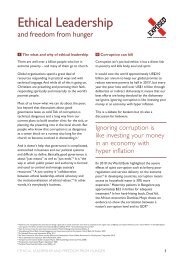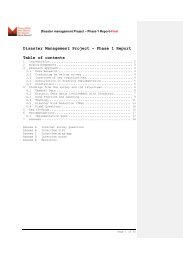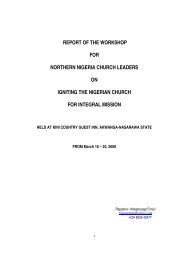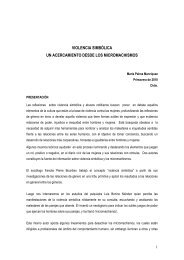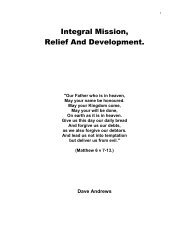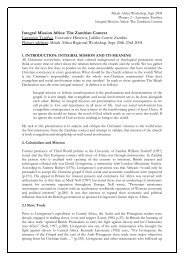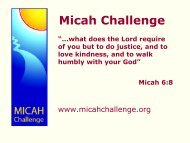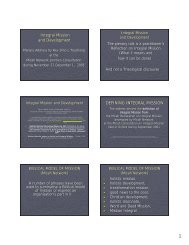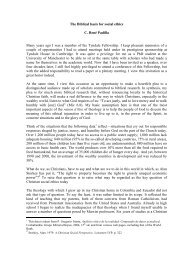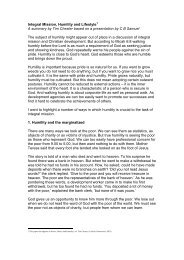STEP 36 Assessingvulnerabilityand capacityROOTS 9REDUCING RISK OF DISASTER IN OUR COMMUNITIESExample 2Hazard –DroughtIMPACT ONELEMENTS AT RISKHealth problemsReduced or zero yield fromfield cropsDeath of livestockReduced number of wildplants / animalsPOSSIBLE VULNERABILITIES WHICH ALLOW THIS IMPACTLack of health knowledgeLack of pure drinking water sourcesCrops not resistant to droughtLack of irrigation systemsAgricultural extension services not adequateSome animals do not cope well with droughtSome animals not in good healthHerds are too largeVeterinary services are absentEven the wild plants / animals are not resistant to the extreme droughtsnow seenDamage (impact) is usually easy to describe, because there is a visible effect of the hazard uponthe community. Vulnerability may be harder to see, because it is often linked to somethingwhich is absent or not accessible to some members of the community.Variations in vulnerabilityVulnerability can vary considerably from country to country. For example, the Caribbeanisland of Cuba is well prepared for hurricanes: vulnerability is low and few lives are lost. Theneighbouring country of Haiti is much poorer and much less well-prepared, and consequentlyvulnerability is high. Hurricanes of equal strength in Haiti cause much damage and loss of life.Even within one village, some families may be highly vulnerable to disaster – through poverty,location or type of housing, sickness in the family etc – while other families in the same villagemay be much less vulnerable. Some social, ethnic or religious groups may be more vulnerablethan others, because they live in areas more affected by the hazard.Within a family or household, vulnerability can vary. Women are often much more vulnerablethan men. Children, the elderly and chronically sick people (including those with HIV) can alsobe highly vulnerable, because they are less able to cope with the impact of hazard events.6.2 CapacitiesAs well as vulnerabilities, a community will possess capacities or strengths which help to reducethe impact of the hazard. Capacities may consist of knowledge or skills, including traditionalways of coping with hazards. They may also include alternative crops or livelihoods, or extendedfamily support mechanisms.Many capacities are hazard-specific, while others are useful against any hazard. For example,banana trees may be a capacity in a flood area, because their trunks can be tied together to48 T E A R F U N D R O O T S R E S O U R C E S
STEP 36 Assessingvulnerabilityand capacityROOTS 9REDUCING RISK OF DISASTER IN OUR COMMUNITIESmake a platform or a simple boat. However, banana trees will be of little use as a capacityagainst earthquake! Other elements, such as savings, a radio or jewellery to sell, will be a usefulcapacity to aid recovery from any disaster event.It is also possible for one asset or activity to be both a vulnerability and a capacity, depen ding onwhich way it is viewed. For example, in times of drought, male or female migra tion in search ofwork is a common coping strategy, or economic capacity. Unfortunately, the separ ation of thefamily can also have negative con sequences. Single-headed house holds result in increased pressureon child ren to undertake more labour or to miss school in order to help with house hold tasks.As a further example, many cultures would consider a large herd of cows to be a sign of wealth,an economic capacity. Unfortunately, in times of drought and scarce pasture the presence of toomany animals, their lack of drought resistance and people’s dependency on a single livelihoodcan all contribute to making the population more vulnerable to the drought.6.3 Assessing vulnerability and capacityThe first step of vulnerability and capacity assessment is to record the actual impact of thehazard on elements in the five categories. Different hazards will affect these categories indifferent ways. For example, a flood may have a very large impact on houses (physical) andlivelihoods (economic), but perhaps a much smaller impact on the forest and fish (naturalresources). On the other hand, a drought may have a big effect on the natural resources, but avery minor impact on physical infrastructure.In the question sets (see Appendix A), the first question in each category is always to do with theimpact of the hazard. A participatory tool (eg a map, seasonal calendar or timeline) will help todefine the impact more clearly and to identify vulnerabilities and capacities. Remember that inthe individual category, impact upon men and upon women may not be the same.When the impact on particular elements is high, the vulnerabilities which allow this impact mustbe identified. This is done by asking a number of ‘why’ questions.If the impact on particular elements is low, these elements are likely to become the capacitieswhich enable a family or community to withstand and recover from the hazard.Individual (male/female) vulnerabilities and capacitiesThis step of the analysis must identify the most vulnerableindividuals in the community. This often includes thewomen and children, and may also include people whoare elderly, sick or physically or mentally less able. Thesegroups’ vulnerability can be due to the particular customsand cultures in place – for example, women may be lessliterate, may be restricted in their movements outsidethe home, or may be expected to feed their husbands andchildren first, ahead of themselves. Women are often excluded from decision-making and planningprocesses, yet carry out much of the work. People suffering from long-term illnesses (eg those© T E A R F U N D 2 0 1 049



